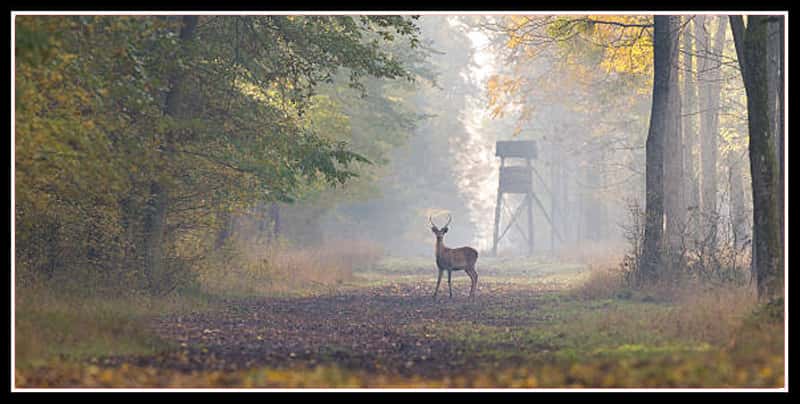Hunters may choose from a broad range of game, including rabbits, hares, squirrels, grouse, and birds, as well as fur-bearing animals like foxes, coyotes, and raccoons. The state also offers a free online check-in service and a program that links hunters with landowners wishing to limit the number of antlerless deer on their property in order to maximize the hunting experience. The cost of a license also changes with the kind of animal being pursued, the time of year, and any other variables.
In this page, we’ll discuss the dates, regulations you need to follow, license and associated fees.
| Overview | Details |
| Required Licensing | You must have a license to go hunting or fishing. |
| Permits to use stamps and annual licenses are valid from April 1 of one year to March 31 of the next. | |
| Depending on the weapon being used and the kind of animal being hunted, several permissions, including combination licenses, are necessary. | |
| What You Can Hunt | Deer |
| Furbearers (e.g., beaver, coyote, raccoon) | |
| Squirrels (e.g., fox, gray, American red squirrels) | |
| Wild Turkeys | |
| Migratory game birds (e.g., ducks, geese, doves) | |
| Where to Hunt | The State offers various public hunting spots. |
| Residents may also enroll their land for the Indiana Private Lands Access (IPLA) Program, which grants authorized hunters public access to private lands. | |
| A reserved hunt draw program is used to manage IPLA hunts. |
Indiana Hunting Seasons 2025
Woodland Big Game
Turkey
| Schedule | Dates |
|---|---|
| Youth | April 19-20, 2025 |
| Spring | April 23-May 11, 2025 |
| Fall – Archery | Oct. 1-26, 2025; Dec. 6, 2025 – Jan. 4, 2026 |
| Firearms | Oct. 15-26, 2025 |
- 1 bearded or male turkey per hunter for Spring and Youth. 1 bird of either sex per hunter each fall
- To hunt a turkey, you need go out between half an hour before dawn and half an hour after dusk.
- For a complete list of turkey-hunting-enabled counties in the fall. During the fall turkey season, hunters are only allowed to take one turkey of each gender. Both the spring and the autumn turkey seasons need their own license.”
- “Half an hour before dawn and half an hour after dusk are prime times for shooting deer.
- Urban Zones, now known as Deer Reduction Zones, are restricted to certain areas.”
Deer
| Season Type | Dates |
|---|---|
| Reduction Zone* | Sept. 15, 2025 – Jan. 31, 2026 |
| Youth Season | Sept. 27-28, 2025 |
| Archery | Oct. 1, 2025 – Jan. 4, 2026 |
| Firearms | Nov. 15 – Nov. 30, 2025 |
| Muzzleloader | Dec. 6 – Dec. 21, 2025 |
Woodland Small Game
| Gray & Fox Squirrel | August 15, 2025 – January 31, 2026 |
| Ruffed Grouse | Suspended |
Upland Birds
| Species | Dates | Daily Limit |
|---|---|---|
| Pheasant (statewide-cock only) | Nov. 1 – Dec. 15, 2025 | 2 |
| Quail (North of I-74) | Nov. 1 – Dec. 15, 2025 | 4 |
| Quail (South of I-74) | Nov. 1, 2025 – Jan. 10, 2026 | 8 |
| Rabbit | Nov. 1, 2025 – Feb. 28, 2026 | 5 |
Furbearers Hunting & Trapping
| Furbearer | Hunting Dates | Trapping Dates | Notes |
|---|---|---|---|
| Red & Gray Fox | Oct. 15, 2025 – Feb. 28, 2026 | Oct. 15, 2025 – Jan. 31, 2026 | |
| Coyote & Striped Skunk | Oct. 15, 2025 – March 15, 2026 | Oct. 15, 2025 – March 15, 2026 | |
| Raccoon & Opossum | Nov. 8, 2025 – Jan. 31, 2026 | Nov. 8, 2025 – Jan. 31, 2026 | |
| Dog Running (Raccoon, Opossum) | Feb. 1 – Oct. 25, 2025 (Chasing only) | (No trapping) | No hunting allowed |
| Beaver | (No hunting) | Nov. 15, 2025 – March 15, 2026 | |
| Mink, Muskrat & Long-Tailed Weasel | (No hunting) | Nov. 15, 2025 – March 15, 2026 | |
| River Otter | (No hunting) | Nov. 15, 2025 – March 15, 2026* | *Permit required |
- Seasonal bag restriction of 2 river otters per person; no daily bag or possession limitations on other species listed above.
- Counties where river otter trapping is permitted may be found in the H&T Guide. In the event that the state’s quota is met before the end of the season, the season may be shortened.”
Indiana Small Game Seasons
| Species | Hunting Dates | Daily Limit |
|---|---|---|
| Green Frog & Bullfrog | June 15, 2024 – April 30, 2026 | 25 |
| Eastern Snapping Turtle, Smooth & Spiny Softshell Turtles | July 1, 2024 – March 31, 2026 | 4 |
| Gray & Fox Squirrel | Aug. 15, 2024 – Jan. 31, 2026 | 5 |
| Rabbit | Nov. 1, 2025 – Feb. 28, 2026 | 5 |
Migratory Birds Dates
| Migratory Birds | Dates | Bag Limit |
|---|---|---|
| Mourning Dove | Sept. 1 – Oct. 20, 2024 | 15* |
| Nov. 1 – Dec. 1, 2024 | 15* | |
| Dec. 21 – 29, 2024 | 15* | |
| Snipe | Sept. 1 – Dec. 16, 2024 | 8 |
| Woodcock | Oct. 15 – Nov. 28, 2024 | 3 |
| Sora Rail | Sept. 1 – Nov. 9, 2024 | 25 |
| Early Teal | Sept. 14 – 29, 2024 | 6 |
🦆Waterfowl
| Zone | Species | Hunting Dates | Daily Limit |
|---|---|---|---|
| NORTH ZONE | Ducks, Coots, Mergansers | Oct. 19 – Dec. 8, 2024 Dec. 28, 2024 – Jan. 5, 2025 | * |
| Canada Geese, Light Geese, Brant | Sept. 1 – 15, 2024 Oct. 19 – 27, 2024 Nov. 23, 2024 – Feb. 9, 2025 | ** | |
| White-fronted Geese | Oct. 19 – 27, 2024 Nov. 23, 2024 – Feb. 9, 2025 | 2*** | |
| Youth & Veteran | Oct. 12 – 13, 2024 | Same as regular season**** | |
| CENTRAL ZONE | Ducks, Coots, Mergansers | Nov. 2 – 10, 2024 Nov. 23, 2024 – Jan. 12, 2025 | * |
| Canada Geese, Light Geese, Brant | Sept. 1 – 15, 2024 Nov. 2 – 10, 2024 Nov. 23, 2024 – Feb. 9, 2025 | ** | |
| White-fronted Geese | Nov. 2 – 10, 2024 Nov. 23, 2024 – Feb. 9, 2025 | 2*** | |
| Youth & Veteran | Oct. 26 – 27, 2024 | Same as regular season**** | |
| SOUTH ZONE | Ducks, Coots, Mergansers | Nov. 9 – 10, 2024 Nov. 30, 2024 – Jan. 26, 2025 | * |
| Canada Geese, Light Geese, Brant | Sept. 1 – 15, 2024 Nov. 9 – 10, 2024 Nov. 23, 2024 – Feb. 15, 2025 | ** | |
| White-fronted Geese | Nov. 9 – 10, 2024 Nov. 23, 2024 – Feb. 15, 2025 | 2*** | |
| Youth & Veteran | Nov. 2 – 3, 2024 | Same as regular season**** |
Legend:
✅ * = Standard bag limits apply per species
✅ ** = Limits vary by species (Check official regulations)
✅ *** = 2 per day for White-fronted Geese
✅ **** = Youth & Veteran season follows regular daily limits
IN Turkey Regulations
- A proper hunting license and a turkey permit are requirements for all turkey hunters.
- Hunters must use a shotgun with a three-shell maximum magazine capacity.
- Hunters must cover at least 400 square inches of their upper bodies with hunter orange during the spring season.
- Within 50 yards of a structure and 150 yards of a public road, turkey hunting is not permitted.
- Hunters 17 years old or younger on the hunt date are specially catered to during the youth season.
- When hunting turkeys between December 9 and December 24, hunters must adhere to the hunter orange regulations.

IN Hunting News and Events
| IN Hunting News and Events | Details |
|---|---|
| Put and Take Pheasant Hunts | Registrations are open for Put and Take pheasant hunts in Indiana from Nov. 18 to 26. |
| Hunters can register at on.IN.gov/reservedhunt for a fee of $30. | |
| Participating Fish & Wildlife areas include Atterbury, Glendale, J.E. Roush Lake, Pigeon River, Tri-County, Willow Slough, and Winamac. | |
| A hunting license and a game bird habitat stamp must be current for the hunter. The daily bag limit is 2 pheasants per person. | |
| The Big Tree Registry Update | The largest known specimen of each native tree species in Indiana is included in The Big Tree Registry, which is being updated by the Indiana Department of Natural Resources (DNR). |
| Nominations require measurements of trunk circumference, total height, and average crown spread. | |
| The largest nominated tree of each native species will be the Big Tree champion. Visit on.IN.gov/big-tree for details and nominations. | |
| National Public Lands Days Celebration | The DNR invites people to celebrate Indiana's public lands on the weekend of Sept. 23 and 24. |
| DNR properties offer free admission on Sunday, Sept. 24, in honor of National Public Lands Day. | |
| It's an opportunity to explore DNR properties for outdoor activities like boating, hiking, and wildlife viewing. Details at on.IN.gov/recfinder. | |
| Volunteer to Prep Waterfowl Blinds | Volunteers are needed to prepare waterfowl hunting blinds in Monroe Lake's Stillwater-Northfork Wildlife Area on Oct. 7. |
| Register at eventbrite.com | |
| Volunteers should dress appropriately, bring tools, and meet at the Northfork check station. | |
| Contact Emmett Holsapple at 812-837-9546 for more information. | |
| National Hunting and Fishing Day | Event: National Hunting and Fishing Day |
| A day to celebrate hunting and fishing in Indiana. Date: Saturday, Sept. 23, 2023 | |
| Free Fishing Day: On this day, Indiana residents are allowed to fish in the state's waters without a fishing license. | |
| Check the Fishing Guide at on.IN.gov/fishingguide for valuable information. |
Indiana Reserved Hunts
Hunters may apply for reserved hunts on state parks and fish & wildlife areas starting August 20, 2023. Participants may shoot deer and birds on these exclusive hunts. Applications are only accepted online via the (IN-DNR) website until 11:59 PM on September 24, 2023. Since there are likely to be many applications, the DNR will employ a random computer program to choose hunters for each hunt.
Registered candidates will get email notifications of results two weeks after the application session ends. Candidates may submit one application every hunt, and once submitted, they cannot be changed. Find details and the application gateway on the Indiana DNR website. The DNR’s internet portal will provide results for those with accounts, and instructions are given for non-members.
| Indiana reserved hunts 2023 | Details |
|---|---|
| Application Opening Date | 20-Aug-23 |
| Application Deadline | September 24, 2023 (11:59 PM) |
| Application Process | Applications for reserved hunts can only be submitted online through the Indiana DNR website. |
| Registration Link | Register for a Reserved Hunt |
| Hunt Types Available | Deer hunts at Fish & Wildlife Areas and State Parks |
| Waterfowl hunts at Fish & Wildlife Areas | |
| Game Bird Area hunts in northern Indiana | |
| Youth-Only Game Bird Area hunts in northern Indiana | |
| Hunts on Indiana Private Land Access for game birds, squirrels, waterfowl, and firearms deer. | |
| Application Rules | Each applicant can submit only one application per hunt. |
| Application details cannot be modified after submission. | |
| Due to the anticipated large number of candidates, each hunt's selection will be done at random. | |
| Results | After the application period concludes, the results will be made public in about two weeks. |
| Email notifications will be sent to registered candidates. | |
| Additional Information | Visit the Indiana DNR website to apply and for comprehensive information on the hunts. |
| Indiana reserved hunt results | Visit the Indiana DNR Portal, sign into your account, and choose "View Registrations" from the Hunt Registrations box to view the draw results. |
| In the "Reserved Hunts" box, click "click here" if you don't already have an account, then enter your customer ID and birthdate. |
Hunting Licenses Fees
Between July 1 and August 31, applicants may submit their programs of choice. For locals, the cost of a hunting or trapping license may be anything from $2 to $25, while out-of-state hunters can pay anywhere from $7 to $300. Apprenticeships and youth permits are also available. Each license is good for one full calendar year, beginning April 1 and ending March 31.
| License Categories | Apprentice | Resident | Nonresident | |
| Res. Youth Consolidated Hunt/Trap | Yes | $12 | NA | |
| Nonres. Annual Youth | Yes | NA | $20 | |
| Nonres. Youth Deer | Yes | NA | $39 | |
| Nonres. Deer License Bundle | Yes | NA | $91 | |
| Nonres. Youth Spring Turkey | Yes | NA | $32 | |
| Nonres. Youth Fall Turkey | Yes | NA | $32 | |
| Nonres. Annual Youth Trapping | No | NA | $20 | |
| Annual & Fishing (Combo Hunt/Fish) | Yes | $32 | NA | |
| Disabled American Veterans Annual Hunt/Fish (Combo Hunt/Fish) | No | $2.75 | NA | |
| Disabled American Veterans 10-Year Hunt/Fish (Combo Hunt/Fish) | No | $27.50 | NA | |
| Annual (License-except deer and turkey) | Yes | $20 | $90 | |
| Five-Day (License) | Yes | NA | $50 | |
| Deer 3 (Deer License) | Yes | $39 | $240 | |
| Deer License Bundle (Deer License) | Yes | $91 | $550 | |
| Spring Turkey | Yes | $32 | $175 | |
| Fall Turkey | Yes | $32 | $175 | |
| Game Bird Habitat Stamp | No | $11 | $11 | |
| Waterfowl Stamp | No | $11 | $11 | |
| Annual Trapping | No | $20 | $140 | |
| Annual Fishing | No | $23 | $60 | |
| Trout/Salmon Stamp | No | $11 | $11 | |
| One-Day Fishing (includes trout/salmon) | No | $10 | $15 | |
| Seven-Day Fishing | No | NA | $35 | |
| Senior Annual Fishing | No | $3 | NA | |
| Senior Fish for Life | No | $23 | NA |
Indiana Hunting Regulations
- Bag limits: When hunting or trapping, it is prohibited to take more than the daily bag limit for wild animals. Except for migrating birds, deer, and wild turkeys, the possession restriction is double the daily bag limit. Any wild animal processed and kept at a person’s principal home is exempt from the possession restriction, except for ducks and migratory birds. It is prohibited to take more than the daily possession limit of wild animals out of Indiana in a vehicle in a single day. Harvested wild animals left unattended must have a tag or be placed in a sealed container or bag that includes the taker’s name and address, the date the animals were taken, and the taker’s signature (s).
- Hours: Turkey may be hunted from half an hour before dawn to half an hour after sunset, except for state-owned land, when the hours may be extended. Deer may be hunted a half-hour before dawn and a half-hour after sundown. No laws prohibit the taking of furbearers by legal means of hunting or trapping. Only rabbits may be taken in February on certain DNR-designated lands, but elsewhere, small game is open season. Waterfowl (ducks and geese) may be hunted legally from half an hour before dawn to half an hour after sunset, except for teals, which can be shot at any time throughout the day. However, shooting times on state-owned land may vary.
- Purple Paint (No Trespassing): Property owners may paint the purple no trespassing signs seen on many properties. This sign has the same legal force as a “No Trespassing” sign and must be visible to anybody approaching the property. Visit iga.IN.gov or consult Indiana Code Section 35-43-2-.2.
- Hunter Orange: When pursuing certain species between November 1 and January 31, such as deer, rabbit, pheasant, quail, turkey, woodcock, and squirrel, hunters must wear hunter orange attire. Hunters must comply by wearing a solid bright orange item that is visible as outer clothing, such as a vest, coat, jacket, coveralls, helmet, or cap, with minimum logos or patches permitted. Fluorescent orange clothing with camouflage patterns does not qualify.
- Remains of Wild Animals: Any Indiana Conservation Officer, other law enforcement officer, DNR property manager or assistant property manager, or wildlife biologist may issue a permit to possess a dead deer, wild turkey, river otter, fox squirrel, gray squirrel, Eastern cottontail rabbit, Northern bobwhite, pheasant, or furbearer (such as a beaver, coyote, fox, mink, muskrat, opossum, raccoon, skunk Permits to possess these creatures may also be issued by a Conservation Officer if they are discovered dead of another cause, or by a person designated by such officer. Dead wildlife that cannot be identified should be reported at on.IN.gov/sickwildlife.
- Disputing the Habitats: The introduction of smoke, fire, fumes, chemicals, a ferret or other small animal, or any mechanical device (other than a lawfully set trap) into the location where a wild animal is hidden or sheltered is prohibited. This includes shooting into the animal’s den, nest, hole, burrow, or house. To avoid disturbing a wild animal from its home or another spot hidden for security or protection, it is prohibited for a human to wear or use a device to climb poles or trees, as well as to carry an axe or saw when in the field at night.
- Trespassing: Hunting, trapping, chasing, or retrieving wildlife on private property is forbidden without the consent of the proprietor or renter.
- Drones: The use of drones to seek, scout, find, or detect wild animals is illegal during season and for the preceding 14 days. However, there are exceptions to using drones in fields including agriculture, animal pest control, and scientific study.
- Party Hunting: Defined as going on a hunt to fill other people’s permits, is prohibited. The legislation of Indiana prohibits this kind of behavior.
- Spotlighting: The use of a spotlight or other artificial light from a moving vehicle while possessing a rifle, bow, or crossbow is prohibited. To take, try to take, or aid another person in taking any wild animal is also forbidden, except for fur-bearing animals, crayfish, and frogs. When fishing, it is also prohibited to use a spotlight or any other artificial light.
- Vehicle or boat hunting: There are certain exceptions to this rule, including for those with impairments and for shooting ducks or squirrels from a stationary speedboat. Riding an off-road vehicle while armed is prohibited unless the rider is in lawful possession of a pistol and is on privately owned or -permitted land.
- Handguns: Concealed weapons carry is permitted at all times; however, deer may only be taken during firearms and muzzleloader seasons and following DNR laws.
- Muzzles, or sound suppressors: Hunting using silencers or suppressors are legal, but only if done legally and following federal regulations. Indiana Code 14-22-38-4.5, however, makes it a Class B misdemeanor to use one for hunting on private property without the permission of the proprietor or renter.
- Carcasses: It is illegal to discard the corpses of lawfully harvested wild animals in rivers, streams, or other waterways since doing so is considered littering and is penalized by penalties. Without the landowner’s consent, burning a body or leaving it out in the open is illegal. Bag it up and take it to the dump, says the DNR.
- Roads or Water: Hunting, shooting, or killing any animal, or shooting at, into, or over a public road, is prohibited. Unless you’re legally pursuing a game, you can’t fire into or over state waterways.
- Hunt Area: The state of Indiana’s Division of Fish & Wildlife oversees 169,164 acres of property for public hunting use. This includes Fish & Wildlife Areas, Wetland Conservation Areas, Wildlife Management Areas, Reservoir assets, and State Forests. You may look for local areas at on.IN.gov/where2hunt.
- Private Property Rights: Hunters interested in participating in the Indiana Private Lands Access program may submit an application at on.IN.gov/reservedhunt during the program’s application season to get access to privately held property for hunting. Check out on.IN.gov/private-lands-access for additional details about the initiative.
- Hunters & Trappers Harassment: On public or private territory, it is prohibited to obstruct another hunter’s authorized pursuit and taking of a game animal.
- Wild Game Selling: Except for furbearers, squirrel tails, deer skins, antlers, hooves, and cured game bird feathers, it is illegal to sell, trade, or barter live or dead protected or controlled wild animals or the meat from them.
- Guidelines for Federal Lands and DNRs: Hunting and trapping rules on state and federal lands might change at any time, so it’s best to check with the property management first.
- Penalties: If you break a law or rule pertaining to fish and wildlife with the purpose to do so, you will be charged with a Class C misdemeanor. In addition to any other penalties under the law, including Class B misdemeanor or Class A misdemeanor classification, a penalty of $500 will be imposed for the illegal taking of a deer or wild turkey (with a prior conviction). Equipment used in willful violation of fish and wildlife rules may be taken as evidence and forfeited by the court.
Frequently Asked Questions
When does the Indiana Hunting Season start and end?
It starts on September 15 and ends on February 29.
What are the different hunting seasons in Indiana?
Outdoor enthusiasts in Indiana have year-round possibilities to hunt throughout different seasons. The season for white-tailed deer usually runs from September 15 to January 31. The season for wild turkeys runs from April 15 to May 15 for fans, while squirrels have plenty of opportunity to hunt small game from August 15 to February 29. Furthermore, the seasons for pheasant and rabbit run from October 15 to February 29 and October 1 to February 29, respectively, offering hunters a variety of chances to interact with the abundant wildlife in Indiana’s natural settings.
What types of firearms are allowed for hunting in Indiana?
Many firearms for hunting are legal in Indiana, catering to different preferences. Hunters may use longbows, recurve bows, and crossbows for a more traditional experience. Hunters may use muzzleloaders for primitive hunting. Shotguns and rifles are allowed, allowing hunters to pick a weapon depending on their tastes and the animal they take.
- 2025 Texas Hunting Season: Latest Dates & New Laws! - March 14, 2025
- Maine Hunting Seasons 2025 New Dates & Limits - March 14, 2025
- Indiana Hunting Season 2025-2026 New Dates & Rules! - February 9, 2025




